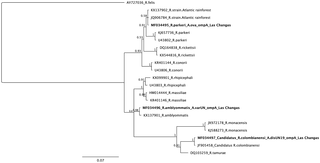PLOS Neglected Tropical Diseases ( IF 3.4 ) Pub Date : 2017-09-18 , DOI: 10.1371/journal.pntd.0005892 Juan C. Quintero V. , Luis E. Paternina T. , Alexander Uribe Y. , Carlos Muskus , Marylin Hidalgo. , Juliana Gil. , Astrid V. Cienfuegos G. , Lisardo Osorio Q. , Carlos Rojas A.

|
Rickettsiosis is a re-emergent infectious disease without epidemiological surveillance in Colombia. This disease is generally undiagnosed and several deadly outbreaks have been reported in the country in the last decade. The aim of this study is to analyze the eco-epidemiological aspects of rickettsial seropositivity in rural areas of Colombia where outbreaks of the disease were previously reported. A cross-sectional study, which included 597 people living in 246 households from nine hamlets in two municipalities of Colombia, was conducted from November 2015 to January 2016. The survey was conducted to collect sociodemographic and household characteristics (exposure) data. Blood samples were collected to determine the rickettsial seropositivity in humans, horses and dogs (IFA, cut-off = 1/128). In addition, infections by rickettsiae were detected in ticks from humans and animals by real-time PCR targeting gltA and ompA genes. Data was analyzed by weighted multilevel clog-log regression model using three levels (person, household and hamlets) and rickettsial seropositivity in humans was the main outcome. Overall prevalence of rickettsial seropositivity in humans was 25.62% (95%CI 22.11–29.12). Age in years (PR = 1.01 95%CI 1.01–1.02) and male sex (PR = 1.65 95%CI 1.43–1.90) were risk markers for rickettsial seropositivity. Working outdoors (PR = 1.20 95%CI 1.02–1.41), deforestation and forest fragmentation for agriculture use (PR = 1.75 95%CI 1.51–2.02), opossum in peridomiciliary area (PR = 1.56 95%CI 1.37–1.79) and a high proportion of seropositive domestic animals in the home (PR20-40% vs <20% = 2.28 95%CI 1.59–3.23 and PR>40% vs <20% = 3.14 95%CI 2.43–4.04) were associated with rickettsial seropositivity in humans. This study showed the presence of Rickettsia antibodies in human populations and domestic animals. In addition, different species of rickettsiae were detected in ticks collected from humans and animals. Our results highlighted the role of domestic animals as sentinels of rickettsial infection to identify areas at risk of transmission, and the importance of preventive measures aimed at curtailing deforestation and the fragmentation of forests as a way of reducing the risk of transmission of emergent and re-emergent pathogens.
中文翻译:

哥伦比亚农村地区立克次体血清阳性的生态流行病学分析:一种多层次方法
立克次氏体病是一种重新出现的传染病,在哥伦比亚没有进行流行病学监测。该疾病通常未被诊断,并且在过去的十年中该国已经报告了几起致命的暴发。这项研究的目的是分析哥伦比亚农村地区病血清阳性的生态流行病学方面,此前曾报道过该病的爆发。2015年11月至2016年1月进行了一项横断面研究,其中包括597个居住在哥伦比亚两个城市的9个小村庄的246户家庭的人。该调查的目的是收集社会人口统计学和家庭特征(暴露)数据。收集血液样本以确定人,马和狗的立克次体血清阳性(IFA,临界值= 1/128)。此外,gltA和ompA基因。使用三个级别(人,家庭和小村庄),通过加权多级阻塞log回归模型分析数据,主要结果是人的立克次体血清阳性。在人类中,立克次体血清阳性的总体患病率为25.62%(95%CI 22.11–29.12)。年龄(PR = 1.01 95%CI 1.01–1.02)和男性(PR = 1.65 95%CI 1.43–1.90)是病血清阳性的危险标志。在户外工作(PR = 1.20 95%CI 1.02-1.41),毁林和用于农业的森林破碎(PR = 1.75 95%CI 1.51-2.02),周边胶质带的负鼠(PR = 1.56 95%CI 1.37–1.79)和家中血清阳性家畜的比例很高(PR 20-40%与<20% = 2.28 95%CI 1.59-3.23和PR > 40%vs <20% = 3.14 95%CI 2.43–4.04)与人的立克次体血清阳性有关。这项研究表明在人群和家畜中存在立克次体抗体。另外,在从人和动物收集的tick中检测到了不同种类的立克次体。我们的研究结果强调了家畜作为立克次氏菌感染的前哨以识别有传播危险的区域的作用,以及旨在减少森林砍伐和森林破碎化的预防措施的重要性,以此来减少发生紧急情况和重新传播的风险。紧急病原体。











































 京公网安备 11010802027423号
京公网安备 11010802027423号